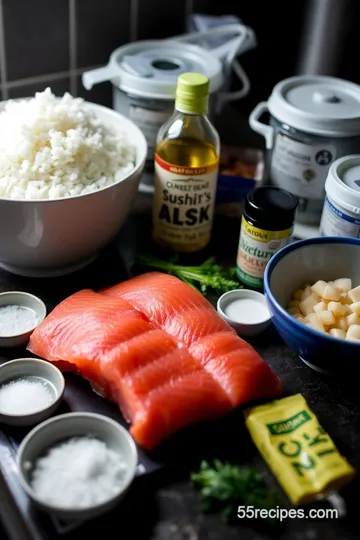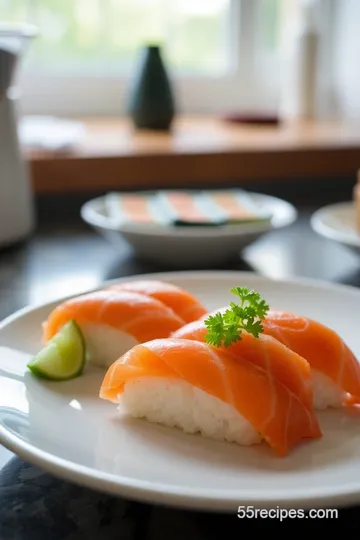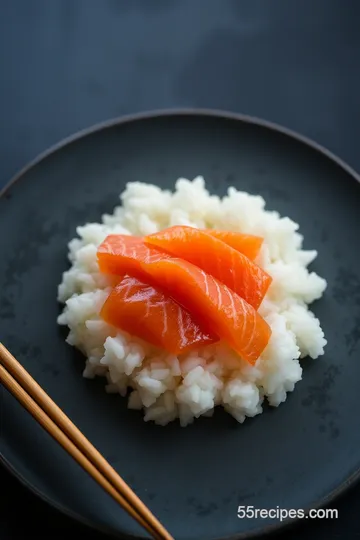Nailed It: Understanding Nigiri vs Sushi – A Complete Guide
Curious about nigiri vs sushi? Discover the secrets of making perfect sushi at home with my easy guide, complete with tips and delicious recipes!

Oh my gosh, have you ever bitten into a piece of sushi and wondered, “what’s the deal with this nigiri vs.
Sushi thing?” i get it! for years, i was right there, scratching my head as i devoured those beautiful rolls and delicate rice bites.
It’s pretty wild that even a sushi lover like me had a hard time keeping all those names straight. today, let’s dive into the scrumptious world of japanese cuisine and break down the differences, the histories, and how to whip up these beauties at home.
You know what makes sushi special? it’s not just the fresh fish or those cute little wasabi and pickled ginger sides; it’s about the culture behind it.
Whether you're serving it up for a special occasion or just a fun night in, understanding nigiri vs. sushi can really elevate your experience in the kitchen.
So, grab a seat, and let’s get tasty!
Recipe Overview
Now, let’s get into where this delightful drama between nigiri and sushi began. the word "sushi" actually refers to a variety of dishes revolving around vinegared rice, while nigiri is one specific type – that classy little hand-formed rice mound topped with fish.
They say sushi started back in ancient japan as a means to preserve fish in fermented rice. over time, it evolved into what we devour today, especially the modern sushi rolls we love so much.
Talk about a glow-up!
Today, sushi is wildly popular – you can find it everywhere from fancy restaurants to food trucks. sure, making sushi at home does take some effort, but trust me, once you nail that sushi rice preparation , you’ll be tossing those rolls together in no time! usually, it takes about 1 hour and 45 minutes to create a batch that serves four.
And hey, the cost isn’t too crazy either, especially if you choose to diy your ingredients. if you’re careful with your fish selection and stick to the basics, you’re looking at a reasonable budget.
Key Benefits
Did you know that sushi has some serious nutritional benefits ? it’s not just tasty—it's loaded with protein, vitamins, and healthy fats, mainly from that omega-3 found in fish.
This is especially true for nigiri, which offers a clean, simple way to enjoy those fresh flavors without any heavy sauces.
Talk about a delicious and satisfying meal!
Plus, serving sushi is like presenting a culinary masterpiece. perfect for birthdays, dinner parties, or even just a cozy night in, it’s definitely the star of any gathering.
And let’s face it—who doesn’t want to impress their friends with some homemade sushi?
Now, compared to traditional cooking methods, sushi-making also encourages you to learn some cool skills—think sushi knife skills and cooking sushi rice to perfection! once you get the basics down, you'll be flexing your culinary muscles in no time.
How about those vegetarian sushi options? you can totally customize your rolls or nigiri with fresh veggies, and they're just as fun and fresh.
From spicy tofu rolls to mango and avocado bites, the world of sushi is your oyster (or veggie!).
So, if you’re ready to make your taste buds dance, let’s take a look at the ingredients you’ll need to start your sushi adventure. We’ll nail this together!

Your Essential Ingredients Guide to Sushi
So, you’ve decided to dive into the world of japanese cuisine . and not just any part of it—you're all about that nigiri vs sushi life! trust me, figuring out what goes into these delightful bites can elevate your sushi game to another level.
Let’s break down the essentials you need to know.
Premium Core Components
First things first, you gotta have your ingredients squared away. starting with sushi rice , you’ll want 2 cups (about 400g) of that sticky goodness.
Pair it with 2 ¼ cups (540ml) of water. pro tip: rinse the rice under cold water until the water runs clear.
That’ll help remove excess starch and make your rice nice and fluffy.
When you're picking the fresh fish , like salmon or tuna for nigiri, look for sushi-grade fish—that means it’s super fresh and safe to eat raw.
Aim for about 8 ounces (227g) . you can tell it’s good quality if the flesh is firm and has a vibrant color.
Always check for that sweet ocean smell, not fishy!
And hey, don’t forget about your seasoning ! a mix of ¼ cup (60ml) rice vinegar, 2 tablespoons (25g) sugar, and 1 teaspoon (6g) salt is key to giving that rice a little tang kick.
Store these ingredients in a cool, dark place and they’ll stay fresh.
Signature Seasoning Blend
Now, let’s spice things up! sushi is all about those flavor profiles . a classic sushi seasoning blends wasabi and pickled ginger for that extra zing.
If you're feeling adventurous, switch it up with some spicy mayo or sriracha! these toppings bring depth and character to your sushi.
Smart Substitutions
We all know that cooking can throw curveballs like missing an ingredient or adhering to dietary restrictions. if you can’t find nori, grab some cucumber slices and create a fresh wrap.
No sushi-grade fish? go with cooked shrimp or crab instead. even if you’re vegan, there are loads of vegetarian sushi options out there using ingredients like avocado , bell peppers , or even grilled veggies !
Kitchen Equipment Essentials
Let’s talk tools. you’ll need a few must-have gadgets for your sushi making journey. a rice cooker is a game-changer for perfect sushi rice preparation , but you could use a pot if you don't have one.
A sharp knife for slicing your fish? non-negotiable! you can also snag a bamboo sushi mat for rolling, which is super handy if you’re making sushi rolls.
Oh, and keep your kitchen organized. A little drawer for your sushi dipping sauces and condiments can help you when it’s time to dip and enjoy!
Why If It Was So Simple?
Here’s the thing, making sushi can feel serious, but it doesn’t have to be intimidating. i remember the first time i tried to make nigiri.
I had rice flying everywhere and the fish didn’t want to cooperate! but you learn, you adapt, and soon you’re crafting those tiny pieces of art like a pro.
It's all about practice and not overthinking it.
Plus, understanding the sushi history behind these dishes adds a special touch. The artistry of sushi has deep cultural significance, and knowing that can give you an appreciation for each bite.
I might've started with takeout, but now i'm excited to make sushi at home and try out new sushi roll variations .
Combine that fresh fish with some good vibes, and you’ll impress all your friends. imagine sitting down to homemade sushi on a friday night—it’s so much more fulfilling than a greasy takeout box.
Ready to assemble your sushi masterpiece? Stay tuned for the simple, step-by-step instructions coming next. You'll be saying, "Nailed it!" in no time!

Nailed It: Understanding Nigiri vs. Sushi – A Complete Guide
When you think about diving into japanese cuisine , one of the first things that comes to mind might be sushi .
And let's be real, sushi is awesome. but do you know the subtle art of nigiri vs. sushi? grab your sushi mat and let’s explore why these two types rock different vibes in the world of sushi!
Essential Preparation Steps
Before we get into the nitty-gritty, let’s map out our game plan. Here’s how to nail it:
-
Mise en Place : This fancy French term just means, “everything in its place.” Have all your ingredients prepped and lined up—trust me, it makes things way smoother.
-
Time management tips : don’t rush it. set a timer for 30 minutes while the rice cooks so you can chill—not literally.
You wanna be on top of your game when making sushi!
-
Organization Strategies : Keep your sushi ingredients tidy. Use small bowls for fillings and toppings. Fish on one board, rice on another. Less chaos, more sushi magic!
-
Safety considerations : always buy sushi-grade fish for your nigiri and sushi. handling raw fish? say it with me: cleanliness is next to sushi-ness.
Wash your hands and surfaces like you mean it!
Step-by-Step Process
Now that we’re all prepped and organized, here’s how to create some sushi masterpieces.
-
Prepare sushi rice : rinse 2 cups sushi rice until the water runs clear—about 3 washes should do it. cook with 2 ¼ cups water .
If you’re using a pot, bring it to a boil and simmer for 20 minutes . remove from heat and let it steam for 10 minutes .
-
Mix It Up : Combine ¼ cup rice vinegar , 2 tablespoons sugar , and 1 teaspoon salt in a bowl. Fold it gently into the cooled rice. Let it chill out.
-
Make Nigiri :
- Wet your hands (this helps with the sticky rice).
- Grab about 2 tablespoons of rice and mold it into an oval shape.
- Slice your fresh fish thinly and place it over the rice. Voilà!
-
Sushi Rolls (If You Dare) :
- Lay a sheet of nori on a bamboo mat, shiny side down.
- Spread a thin layer of rice, add your fillings, and roll tight. Seal the edge with water and slice into bite-sized pieces.
Expert Techniques
Alright, let’s kick it up a notch!
-
Use a sharp knife for slicing! This is where sushi knife skills matter. Clean cuts make for prettier sushi and better taste!
-
When cooking sushi rice, keeping your eye on the temperature and timing is crucial! Always let it cool to room temp before assembling; hot rice wilts nori like a sad plant.
-
Use visual cues for doneness as well. Look for that lovely, fluffy texture of perfectly cooked rice; it’s a game-changer!
Success Strategies
Now don’t get too cocky; even pros make mistakes!
-
Common Mistakes : Don’t overstuff your rolls. It’s tempting, but the more fillings you add, the harder it is to roll and slice neatly.
-
Quality Checkpoints : Always check the smell of your fish. Fresh fish should smell like the ocean—use your nose!
-
Make-ahead Options : You can prep your sushi rice a day ahead—just store it in the fridge and rewarm slightly before rolling.
Wrapping It Up
Sushi is a delightful adventure in the kitchen, but remember, practice makes perfect. don't beat yourself up if your nigiri sushi recipe doesn’t come out instagram-ready right away.
It takes time to master it. honestly, even if you start making sushi at home as a beginner, it can turn into an impressive skill.
And the best part? you can always switch it up and try out various sushi roll variations !
As you hit the kitchen, keep those sushi making tips close to your heart. the next time you’re caught in a sushi debate— nigiri vs sushi —you can confidently whip up some delicious bites for your friends or family.
So, what’s next on your sushi journey? we’ll dive into more sushi preparation tips in the next section, covering everything from sushi dining etiquette to fun fusion sushi ideas.
Hang tight—your sushi skills are just getting warmed up!

Additional Recipe Information: Diving Deeper into Nigiri vs. Sushi
Alright, my food-loving pals, if you've ever found yourself pondering nigiri vs. sushi , you know you're standing at the crossroads of two delightful aspects of japanese cuisine .
But let’s not just scratch the surface. let’s dive into some pro tips, presentation advice, storage secrets, and creative ideas for your sushi-making adventures! so grab a cup of tea and let's chat.
Pro Tips & Secrets for Perfect Sushi
First off, here's a little insider info straight from my kitchen: sushi making tips can save you both time and heartache.
For instance, when you're preparing that sushi rice , rinsing the grains until the water runs clear is crucial. it keeps your rice from getting all goopy.
Trust me, i’ve made that mistake before and ended up with something that resembled glue, not sushi!
Use sharp knife skills when slicing your fish. a clean cut means beautiful pieces that don’t tear apart. also, if you're looking to save time, prep your fillings ahead of time.
On busy nights, i’ll slice cucumbers or avocado and store them in the fridge. then, when it’s sushi o'clock, i’m ready to rock with minimal fuss.
Perfect Presentation Every Time
Now, we all know we eat with our eyes first, right? so how do we make our sushi look as good as it tastes? here are some plating techniques that i swear by.
Choose a beautiful platter or bamboo board to arrange your nigiri sushi and rolls.
- Garnish Ideas: A sprinkle of sesame seeds or a few leaves of microgreens can take your dish from plain to wow!
- Color Combinations: Balance is key. Use vibrant veggies like bright green avocado alongside pink salmon for that Instagram-worthy shot.
- Visual Appeal Tips: Think layers! Stacking your sushi high or placing nigiri at varying angles can create visual dynamism on the plate.
Storage & Make-Ahead Strategies
Now, let's talk storage because nobody wants their sushi to be past its prime! storage guidelines are straightforward. keep your sushi rice in an airtight container in the fridge for up to three days.
Just know that fresh fish needs to be handled like royalty – use it within 24 hours for the best taste.
If you’ve got leftover sushi rolls, wrap them tightly in plastic wrap and refrigerate. when reheating, just know sushi isn’t the best candidate for the microwave; it goes soggy.
Instead, enjoy it cold or let it warm up unchanged at room temperature for a while before you dig in.
Creative Variations
There's no reason to stick to the classics when making sushi! think about your audience or the season. you could easily create vegetarian sushi options by swapping in grilled zucchini or roasted sweet potatoes.
Or try a spicy twist with sriracha sauce and pickled veggies for a kick!
Maybe you want to switch up your sushi with a fusion twist? why not incorporate some ingredients that reflect your local flavors? in my area, we’ve got great local seafood, so i love adapting those catches into my sushi roll variations .
Endless possibilities, my friends!
Complete Nutrition Guide
Now, what about health? the nutritional benefits of sushi are pretty impressive! it’s loaded with omega-3 fatty acids when you choose fish like salmon or tuna.
Plus, sushi ingredients like avocado and seaweed provide healthy fats and fiber.
Just remember to watch your portions. each serving generally provides around 280 calories, but that can vary based on what you stuff into your rolls or how much fish you load onto those tiny rice ovals.
Wrap It Up with Love!
Alrighty, everyone, whether you’re making this to impress your friends or serve at a family dinner, diving into the nigiri vs sushi debate is just the beginning.
You’re not just cooking; you’re creating art. embrace the messiness, the experimentations, and the flavors that come together.
So, while you’re at it, don’t hesitate to share your creative spins and sushi stories! making sushi isn't just about food; it’s about the experience, the fun, and the memories you’ll create around the table.
Happy rolling, friends!
Frequently Asked Questions
What is the main difference between nigiri and sushi?
Nigiri is a specific type of sushi that consists of a small ball of vinegared rice topped with a slice of fish or seafood. In contrast, sushi can refer to a variety of dishes, including rolls (makizushi), where rice is rolled with different fillings, making it a broader term encompassing many styles.
Can you explain nigiri vs sushi in simple terms?
Sure! Nigiri is hand-formed rice topped with a slice of fish, while sushi can include various sushi rice preparations, including rolls and other combinations. Essentially, all nigiri is sushi, but not all sushi is nigiri.
What type of fish is best for making nigiri?
For nigiri, opt for sushi-grade fish such as salmon, tuna, or yellowtail. These types of fish are not only safe to eat raw but also have a delicate flavor and texture that pairs well with vinegared rice.
How should I store leftover nigiri and sushi?
Store leftover nigiri or sushi in an airtight container in the refrigerator for up to 24 hours. However, for the best flavor and texture, it's recommended to eat them fresh, as the rice can harden and the fish may lose its freshness over time.
Is nigiri healthy compared to other sushi types?
Nigiri can be considered a healthy option, as it primarily consists of fish, a good source of protein, and vinegared rice, which is usually lower in fat. However, portion control is key, as some sushi rolls can contain higher calorie and fat content due to added sauces or fried ingredients.
What are some variations I can try for nigiri and sushi?
You can experiment with different toppings for nigiri beyond traditional fish, such as grilled vegetables or even marinated tofu for a vegetarian option. Furthermore, try using quinoa instead of sushi rice to create a unique twist on sushi rolls!
Nailed It: Understanding Nigiri vs Sushi – A Complete Guide Card

⚖️ Ingredients:
- 2 cups sushi rice (about 400g)
- 2 ¼ cups water (540ml)
- ¼ cup rice vinegar (60ml)
- 2 tablespoons sugar (25g)
- 1 teaspoon salt (6g)
- 8 ounces sushi-grade fish (like salmon or tuna) (227g), sliced into thin pieces
- Wasabi, for serving
- Pickled ginger, for serving
- 4 sheets nori (seaweed)
- Assorted fillings (e.g., cucumber, avocado, crab sticks)
- Soy sauce, for serving
🥄 Instructions:
- Step 1: Rinse sushi rice under cold water until water runs clear.
- Step 2: Combine rice and water in a rice cooker or pot.
- Step 3: Cook according to the rice cooker instructions or bring to a boil, then simmer for about 20 minutes.
- Step 4: Remove from heat and let sit for 10 minutes.
- Step 5: Mix rice vinegar, sugar, and salt in a small bowl until dissolved, then gently fold into the rice. Let it cool.
- Step 6: Wet your hands to prevent sticking, and take a small portion of sushi rice (about 2 tablespoons).
- Step 7: Form a compact oval shape.
- Step 8: Thinly slice your fish and place it gently over the rice.
- Step 9: Serve with a small dab of wasabi, if desired.
- Step 10: Lay a sheet of nori on the bamboo mat, shiny side down.
- Step 11: Spread a thin layer of sushi rice over the nori, leaving a 1-inch border at the top.
- Step 12: Add your chosen fillings linearly across the rice.
- Step 13: Roll the sushi tightly from the bottom, using the mat to help.
- Step 14: Seal the edge with a bit of water and slice into bite-sized pieces.
Previous Recipe: Easy Homemade Düsseldorf Mustard: A Tangy German Classic Recipe
Next Recipe: How Long is Chicken Salad Good For? My Easy and Flavorful Recipe
